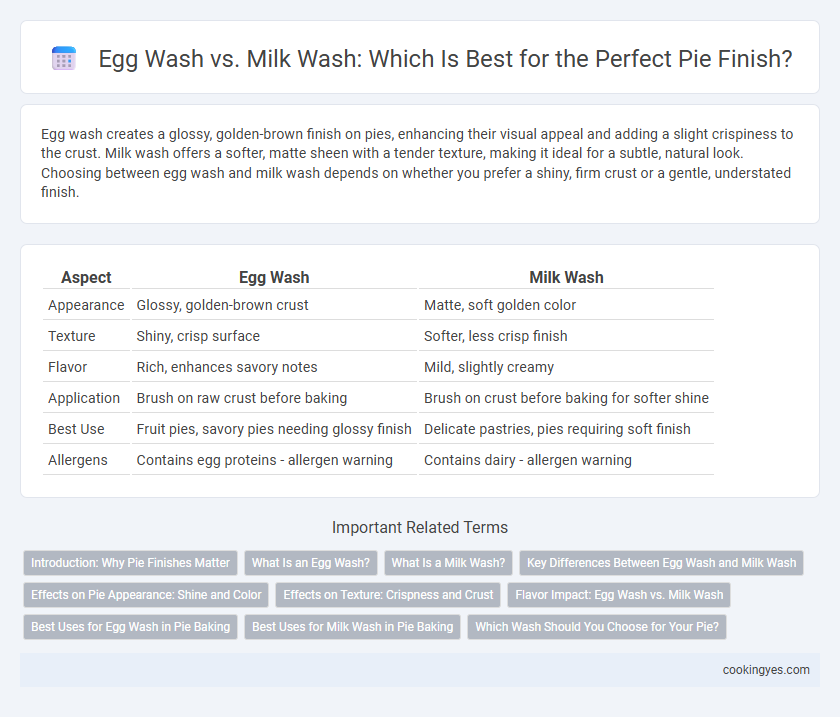Egg wash creates a glossy, golden-brown finish on pies, enhancing their visual appeal and adding a slight crispiness to the crust. Milk wash offers a softer, matte sheen with a tender texture, making it ideal for a subtle, natural look. Choosing between egg wash and milk wash depends on whether you prefer a shiny, firm crust or a gentle, understated finish.
Table of Comparison
| Aspect | Egg Wash | Milk Wash |
|---|---|---|
| Appearance | Glossy, golden-brown crust | Matte, soft golden color |
| Texture | Shiny, crisp surface | Softer, less crisp finish |
| Flavor | Rich, enhances savory notes | Mild, slightly creamy |
| Application | Brush on raw crust before baking | Brush on crust before baking for softer shine |
| Best Use | Fruit pies, savory pies needing glossy finish | Delicate pastries, pies requiring soft finish |
| Allergens | Contains egg proteins - allergen warning | Contains dairy - allergen warning |
Introduction: Why Pie Finishes Matter
Pie finishes significantly enhance the visual appeal and texture of baked pies, crucial for creating an inviting golden crust. Egg wash, composed of beaten eggs or egg yolks, imparts a rich color and glossy sheen while promoting an even browning effect. Milk wash offers a more subtle shine and softer crust texture, ideal for delicate pastries requiring a gentle finish.
What Is an Egg Wash?
An egg wash is a mixture of beaten eggs, sometimes combined with water or milk, applied to pastry surfaces before baking to create a glossy, golden finish. The proteins and fats in the egg wash enhance browning through the Maillard reaction, resulting in a richer color and slight crispness. This technique is preferred over milk wash when a deeper shine and more pronounced crust texture are desired on pies.
What Is a Milk Wash?
A milk wash is a simple finishing technique for pies that involves brushing milk onto the crust before baking to achieve a golden-brown color and subtle sheen. Unlike egg wash, which contains proteins and can create a glossy, firm crust, milk wash imparts a softer, slightly matte finish with mild browning due to the natural sugars and fats in the milk. Using whole milk or cream enhances browning, making it a preferred choice for a tender, rustic pie crust appearance.
Key Differences Between Egg Wash and Milk Wash
Egg wash, made from beaten eggs or egg yolks, provides a rich, glossy, and golden-brown finish on pie crusts, enhancing both color and texture with a slightly crisp surface. Milk wash results in a softer, matte finish with a lighter browning effect, adding subtle moisture without the shine or crispness found in egg wash. Choosing between egg wash and milk wash impacts the pie's visual appeal and texture, with egg wash offering a more pronounced, decorative crust and milk wash yielding a tender, understated finish.
Effects on Pie Appearance: Shine and Color
Egg wash creates a glossy, golden-brown crust on pies due to proteins and fats that caramelize during baking, resulting in a vibrant and shiny finish. Milk wash provides a softer, matte surface with a lighter, more subtle browning effect, ideal for a natural appearance. Choosing between egg wash and milk wash impacts the visual appeal by enhancing either a rich gloss or a gentle sheen on the pie's crust.
Effects on Texture: Crispness and Crust
Egg wash enhances pie crust texture by promoting a glossy, golden-brown finish with a crisp outer layer due to its protein content, which helps with browning and structure. Milk wash, containing lactose and proteins, creates a softer, matte crust texture that retains moisture and offers a tender bite. Choosing egg wash results in a crunchier, visually shiny crust, while milk wash yields a gentler crispness with a smooth, less brittle surface.
Flavor Impact: Egg Wash vs. Milk Wash
Egg wash enhances pie crusts with a richer, deeper flavor due to its protein and fat content, creating a glossy, golden sheen that intensifies browning. Milk wash results in a softer crust with a subtle sweetness and a less pronounced shine, contributing mild flavor without overpowering the pie's filling. Choosing egg wash amplifies savory or rich pies, while milk wash suits fruit or custard pies where a delicate finish is preferred.
Best Uses for Egg Wash in Pie Baking
Egg wash, made from beaten eggs sometimes mixed with water or milk, is ideal for achieving a glossy, golden-brown crust on pies, enhancing both appearance and texture. It provides excellent adhesion for toppings like sugar or nuts, making it perfect for decorative pie finishes and lattice tops. Egg wash also helps create a slightly crispier crust compared to milk wash, which is better suited for softer, more matte finishes.
Best Uses for Milk Wash in Pie Baking
Milk wash enhances pie crusts by creating a soft, golden-brown finish that is ideal for fruit pies and tarts where a delicate, subtle sheen is desired. It adds moisture and promotes browning without the richer, glossy effect of egg wash, making it perfect for lighter pastries and sweet crusts. Milk wash also helps to slightly caramelize sugar sprinkled on top, boosting the crust's texture and flavor.
Which Wash Should You Choose for Your Pie?
Egg wash creates a glossy, golden-brown finish that enhances the pie's appearance and adds a subtle crunch, making it ideal for fruit pies or lattice crusts. Milk wash produces a softer, matte finish with a gentle browning effect, perfect for tender, flaky crusts or cream pies that require a delicate touch. Choose egg wash for a visually striking, crisp crust and milk wash for a softer, more understated pie finish.
Egg Wash vs Milk Wash for Pie Finish Infographic

 cookingyes.com
cookingyes.com